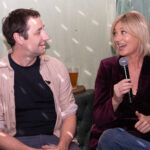The legacy of Holocaust survivors in Australia will be shored up for future generations with the help of a $6.25 million budget pledge to expand education programs, the head of the Sydney Jewish Museum has said.
In an interview with Central News chief executive Norman Seligman added the grant from the state government would allow the museum to reach more people with its universal messages of respect, tolerance and standing against injustice.
“It’s to actually understand how it happened, why it happened and the relevance today,” he said.
“In fact, that’s really an important thing for us, to make sure that people understand the relevance of what happened during the Holocaust for us living today.
“It started with words, but ultimately ended up in laws and ultimately ended in death, and violence, and genocide. So when you start with, just even with words, you’re on a very slippery slope which can very quickly get out of control.”

Sydney Jewish Museum CEO Norman Seligman. Photo: supplied.
These upgrades are expected to raise the capacity to allow 20 per cent more students to visit each year, who make up over half of the museum’s visitors.
Mr Seligman notes over 90 per cent of the students come from non-Jewish backgrounds, highlighting the importance of the broader lessons which can be learned from the Holocaust.
What starts off looking small and inconsequential can often have a very, very bad result and people should be aware of that.
One of these lessons is to stand up and recognise similar examples of intolerance and lack of respect.
“It can be face-to-face or on social media, which is really happening in a big way these days,” Mr Seligman said. “We need to understand the consequences of these things.
“What starts off looking small and inconsequential can often have a very, very bad result and people should be aware of that.”
As part of the NSW budget announced on Tuesday, NSW Treasurer Dominic Perrottet outlined the government’s commitment to preserving Holocaust stories for future generations.
Of the money, $3.5 million will be dedicated to a new education building for visiting students and a further $2.75 million will be spent on temporary exhibitions and archives.
“As we come closer to a time when Holocaust survivors will no longer be able to share their stories, this expansion of the Sydney Jewish Museum will provide a vital link to ensure the Holocaust is always remembered by future generations,” Treasurer Dominic Perrottet said.
Mr Seligman said preserving the voices of the Holocaust survivors and allowing them to teach these lessons was of utmost priority for the museum. and the money would be used to fund the roll-out of regional programmes as well as expanding archives and exhibits.
“When people leave the museum, the thing that has the biggest impact on them is listening to a Holocaust survivor, so we want to make sure that going into the future that they will still be able to listen to the voice of the survivor, describing what has happened to them during the Holocaust,” he added.
“They have rebuilt their lives which is a really inspirational story. When the students listen to that they are really taken aback.”

Sydney Jewish Museum. Photo: supplied.
The Sydney Jewish Museum is particularly excited about being able to launch their program ‘Dimensions in Testimony’ at the end of this year, as part of a collaboration with the Shoah Foundation in Los Angeles.
The program will feature what can be simply described as ‘holograms’ which will allow students and adult visitors to talk to Holocaust survivors, even after they cease volunteering at the museum.
“There’ll be an interactive hologram where you will be able to ask a survivor a question as if they are right there in front of you, and they will respond to you in real-time,” Mr Seligman said.
Our current high-tech filming project captures the stories of 6 Australian Holocaust survivors in three dimensions to allow future generations to have lifelike conversations with them in the museum.
Project in partnership with @USCShoahFdn. https://t.co/GqnBJEoZNS
— Sydney Jewish Museum (@SydJewishMuseum) January 20, 2021
“In order to achieve this… we interviewed each survivor for a whole week, probably for at least five hours a day… and asked anywhere from 1,000 to 1,500 questions, trying to come up with every possible question someone could ask in the future.”
Holocaust survivors, such as Olga Horak (pictured, above), regularly give talks to students and visitors at the museum about their experiences. The moving accounts of the approximately 40 active survivors are arguably the museum’s most valued attribute.
“We lose a couple of our survivors each year through the main fact that they simply get too frail to want to come in, things like dementia happen or some people pass away,” Mr Seligman said.
“It is very expensive technology, it is very time consuming but it is one of the ways we will preserve the stories of the Holocaust survivors into the future.”
Overall, he said, the museum is incredibly grateful to the NSW Government for providing the grant.
“This is something we have been planning for a couple of years already… fortunately the funding has come from the government,” Mr Seligman said.

Students attending an educational tour at the museum. Photo: supplied.
“It will go a long way towards ensuring that we are able to grow and ensure that for the future the museum plays a very active role in not only the education about the Holocaust but Judaism and Australian Jewish life in general.”
Main image of Holocaust survivor, Olga Horak, at the museum. Photo: Sydney Jewish Museum.
Story by Gracie Abadee @GracieAbadee.




























